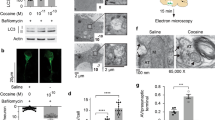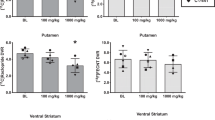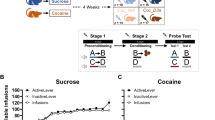Abstract
Adenosine is an endogenous purine nucleoside, which acts as a neuromodulator in the central nervous system. A2A adenosine and D2 dopamine receptors are colocalized in the same neurons in discrete brain areas, and the dopaminergic transmission plays a crucial role in the addictive properties of drugs of abuse, such as cocaine. In the present study, we have investigated the specific role of A2A adenosine receptors in cocaine-induced behavioral responses related to its addictive properties. For this purpose, we have evaluated the acute locomotor effects produced by cocaine and the development of locomotor sensitization by repeated cocaine administration. In addition, we have also examined cocaine acute rewarding properties using the conditioned place preference. Finally, we used the intravenous drug self-administration paradigm to investigate the acquisition of an operant response maintained by cocaine self-administration and the reinforcing efficacy of the drug in these knockout animals. Acute cocaine induced a similar increase of locomotor activity in mice lacking A2A adenosine receptors and wild-type littermates. Cocaine-induced locomotor sensitization and conditioned place preference were also maintained in A2A knockout mice. Nevertheless, these knockout mice showed a lower rate of cocaine self-administration than wild-type mice in both fixed ratio 1 and 3 schedules of reinforcement. Moreover, a reduction in the maximal effort to obtain a cocaine infusion was found in A2A knockout mice under a progressive ratio schedule. In addition, a vertical shift of the cocaine dose–response curve was observed in mice lacking A2A adenosine receptors in comparison with wild-type littermates. Our study demonstrates that A2A adenosine receptors play an important role in cocaine addictive properties, and these receptors seem to be required to develop the addictive effects of this drug.
Similar content being viewed by others
Log in or create a free account to read this content
Gain free access to this article, as well as selected content from this journal and more on nature.com
or
References
Baldo BA, Koob GF, Markou A (1999). Role of adenosine A2 receptors in brain stimulation reward under baseline conditions and during cocaine withdrawal in rats. J Neurosci 19: 11017–11026.
Bastia E, Xu YH, Scibelli AC, Day YJ, Linden J, Chen JF et al (2005). A crucial role for forebrain adenosine A(2A) receptors in amphetamine sensitization. Neuropsychopharmacology 30: 891–900.
Berrendero F, Castañe A, Ledent C, Parmentier M, Maldonado R, Valverde O (2003). Increase of morphine withdrawal in mice lacking A2a receptors and no changes in CB1/A2a double knockout mice. Eur J Neurosci 17: 315–324.
Caine SB, Negus SS, Mello NK (1999). Method for training operant responding and evaluating cocaine self-administration behavior in mutant mice. Psychopharmacology 147: 22–24.
Caine SB, Negus SS, Mello NK, Patel S, Bristow L, Kulagowski J et al (2002). Role of dopamine D2-like receptors in cocaine self-administration: studies with D2 receptor mutant mice and novel D2 receptor antagonists. J Neurosci 22: 2977–2988.
Chen JF, Beilstein M, Xu YH, Turner TJ, Moratalla R, Standaert DG et al (2000). Selective attenuation of psychostimulant-induced behavioral responses in mice lacking A(2A) adenosine receptors. Neuroscience 97: 195–204.
de Mendonca A, Ribeiro JA (1997). Adenosine and neuronal plasticity. Life Sci 60: 245–251.
Di Chiara G (2002). Nucleus accumbens shell and core dopamine: differential role in behavior and addiction. Behav Brain Res 137: 75–114.
Ferré S, Fredholm BB, Morelli M, Popoli P, Fuxe K (1997). Adenosine–dopamine receptor–receptor interactions as an integrative mechanism in the basal ganglia. Trends Neurosci 20: 482–487.
Franco R, Ferré S, Agnati L, Torvinen M, Gines S, Hillion J et al (2000). Evidence for adenosine/dopamine receptor interactions: indications for heteromerization. Neuropsychopharmacology 23: S50–S59.
Hauber W, Bareiss A (2001). Facilitative effects of an adenosine A1/A2 receptor blockade on spatial memory performance of rats: selective enhancement of reference memory retention during the light period. Behav Brain Res 118: 43–52.
Hooks MS, Jones GH, Smith AD, Neill DB, Justice Jr JB (1991a). Response to novelty predicts the locomotor and nucleus accumbens dopamine response to cocaine. Synapse 9: 121–128.
Hooks MS, Jones GH, Smith AD, Neill DB, Justice Jr JB (1991b). Individual differences in locomotor activity and sensitization. Pharmacol Biochem Behav 38: 467–470.
Hummel M, Unterwald EM (2002). D1 dopamine receptor: a putative neurochemical and behavioral link to cocaine action. J Cell Physiol 191: 17–27.
Justinova Z, Ferré S, Segal PN, Antoniou K, Solinas M, Pappas LA et al (2003). Involvement of adenosine A1 and A2A receptors in the adenosinergic modulation of the discriminative-stimulus effects of cocaine and methamphetamine in rats. J Pharmacol Exp Ther 307: 977–986.
Kalivas PW, Striplin CD, Steketee JD, Klitenick MA, Duffy P (1992). Cellular mechanisms of behavioral sensitization to drugs of abuse. Ann NY Acad Sci 654: 128–135.
Kaplan GB, Sears MT (1996). Adenosine receptor agonists attenuate and adenosine receptor antagonists exacerbate opiate withdrawal signs. Psychopharmacology 123: 64–70.
Knapp CM, Foye MM, Cottam N, Ciraulo DA, Kornetsky C (2001). Adenosine agonists CGS 21680 and NECA inhibit the initiation of cocaine self-administration. Pharmacol Biochem Behav 68: 797–803.
Koob GF (1996). Hedonic valence, dopamine and motivation. Mol Psychiatry 1: 186–189.
Koob GF, Le Moal M (2001). Drug addiction, dysregulation of reward, and allostasis. Neuropsychopharmacology 24: 97–129.
Ledent C, Vaugeois JM, Schiffmann SN, Pedrazzini T, El Yacoubi M, Vanderhaeghen JJ et al (1997). Aggressiveness, hypoalgesia and high blood pressure in mice lacking the adenosine A2a receptor. Nature 388: 674–678.
Maldonado R, Saiardi A, Valverde O, Samad TA, Roques BP, Borrelli E (1997). Absence of opiate rewarding effects in mice lacking dopamine D2 receptors. Nature 388: 586–589.
Meisch RA, Lemaire GA (1993). Drug self-administration. In: Haaren F (ed). Methods in Behavioral Pharmacology. Elsevier Science Publishers BV: New York. pp 257–300.
Moreau JL, Huber G (1999). Central adenosine A(2A) receptors: an overview. Brain Res Brain Res Rev 31: 65–82.
Nairn AC, Svenningsson P, Nishi A, Fisone G, Girault JA, Greengard P (2004). The role of DARPP-32 in the actions of drugs of abuse. Neuropharmacology 47(Suppl 1): 14–23.
Nestler EJ (2004). Molecular mechanisms of drug addiction. Neuropharmacology 47(Suppl 1): 24–32.
Piazza PV, Deminiere JM, Le Moal M, Simon H (1989). Factors that predict individual vulnerability to amphetamine self-administration. Science 245: 1511–1513.
Piazza PV, Deroche-Gamonent V, Rouge-Pont F, Le Moal M (2000). Vertical shifts in self-administration dose–esponse functions predict a drug-vulnerable phenotype predisposed to addiction. J Neurosci 20: 4226–4232.
Poleszak E, Malec D (2002). Adenosine receptor ligands and cocaine in conditioned place preference (CPP) test in rats. Pol J Pharmacol 54: 119–126.
Robinson TE, Berridge KC (1993). The neural basis of drug craving: an incentive-sensitization theory of addiction. Brain Res Brain Res Rev 18: 247–291.
Salem A, Hope W (1997). Effect of adenosine receptor agonists and antagonists on the expression of opiate withdrawal in rats. Pharmacol Biochem Behav 57: 671–679.
Soria G, Castañé A, Berrendero F, Ledent C, Parmentier M, Maldonado R et al (2004). Adenosine A2A receptors are involved in physical dependence and place conditioning induced by THC. Eur J Neurosci 20: 2203–2213.
Soria G, Mendizábal V, Touriño C, Robledo P, Maldonado R, Valverde O (2005). Lack of CB1 cannabinoid receptor impairs cocaine self-administration. Neuropsychopharmacology (doi:10.1038/sj.npp1300707).
Svenningsson P, Le Moine C, Fisone G, Fredholm BB (1999). Distribution, biochemistry and function of striatal adenosine A2A receptors. Prog Neurobiol 59: 355–396.
Svenningsson P, Lindskog M, Ledent C, Parmentier M, Greengard P, Fredholm BB et al (2000). Regulation of the phosphorylation of the dopamine- and cAMP-regulated phosphoprotein of 32 kDa in vivo by dopamine D1, dopamine D2, and adenosine A2A receptors. Proc Natl Acad Sci USA 97: 1856–1860.
Svenningsson P, Nishi A, Fisone G, Girault JA, Nairn AC, Greengard P (2004). DARPP-32: an integrator of neurotransmission. Annu Rev Pharmacol Toxicol 44: 269–296.
Vanderschuren LJ, Kalivas PW (2000). Alterations in dopaminergic and glutamatergic transmission in the induction and expression of behavioral sensitization: a critical review of preclinical studies. Psychopharmacology 151: 99–120.
Valjent E, Corvol JC, Pages C, Besson MJ, Maldonado R, Caboche J (2000). Involvement of the extracellular signal-regulated kinase cascade for cocaine-rewarding properties. J Neurosci 20: 8701–8709.
Valjent E, Herve D, Caboche J, Girault JA (2003). Possible role of the extracellular signal-regulated kinase (ERK) in reward-controlled learning and addiction. Curr Neuropharmacol 1: 165–174.
Valjent E, Pascoli V, Svenningsson P, Paul S, Enslen H, Corvol JC et al (2005). From The Cover: regulation of a protein phosphatase cascade allows convergent dopamine and glutamate signals to activate ERK in the striatum. Proc Natl Acad Sci USA 102: 491–496.
Weerts EM, Griffiths RR (2003). The adenosine receptor antagonist CGS15943 reinstates cocaine-seeking behavior and maintains self-administration in baboons. Psychopharmacology 168: 155–163.
Yao L, Arolfo MP, Dohrman DP, Jiang Z, Fan P, Fuchs S et al (2002). betagamma Dimers mediate synergy of dopamine D2 and adenosine A2 receptor-stimulated PKA signaling and regulate ethanol consumption. Cell 109: 733–743.
Yao L, Fan P, Jiang Z, Mailliard WS, Gordon AS, Diamond I (2003). Addicting drugs utilize a synergistic molecular mechanism in common requiring adenosine and Gi-beta gamma dimers. Proc Natl Acad Sci USA 100: 14379–14384.
Zachariou V, Benoit-Marand M, Allen PB, Ingrassia P, Fienberg AA, Gonon F et al (2002). Reduction of cocaine place preference in mice lacking the protein phosphatase 1 inhibitors DARPP 32 or Inhibitor 1. Biol Psychiatry 51: 612–620.
Acknowledgements
This study was supported by grants from Spanish MCYT (SAF 2001/0745, SAF 2004/568, and GEN2003-20651-C06-04), HFSP (RG007/200-B), Redes del Instituto de Salud Carlos III (C03/06 and G03/005), and European Communities (NEWMOOD OJ2003/C164-05166). GS is a fellowship from Spanish MCYT. AC is a fellowship from DURSI (Generalitat de Catalunya).
Author information
Authors and Affiliations
Corresponding author
Rights and permissions
About this article
Cite this article
Soria, G., Castañé, A., Ledent, C. et al. The Lack of A2A Adenosine Receptors Diminishes the Reinforcing Efficacy of Cocaine. Neuropsychopharmacol 31, 978–987 (2006). https://doi.org/10.1038/sj.npp.1300876
Received:
Accepted:
Published:
Issue date:
DOI: https://doi.org/10.1038/sj.npp.1300876
Keywords
This article is cited by
-
Adenosine A2A receptor in schizophrenia: an in vivo brain PET imaging study
Psychopharmacology (2022)
-
Effects of intra-accumbal or intra-prefrontal cortex microinjections of adenosine 2A receptor ligands on responses to cocaine reward and seeking in rats
Psychopharmacology (2018)
-
Effects of the adenosinergic system on the expression and acquisition of sensitization to conditioned place preference in morphine-conditioned rats
Naunyn-Schmiedeberg's Archives of Pharmacology (2016)
-
Chronic Administration of the Methylxanthine Propentofylline Impairs Reinstatement to Cocaine by a GLT-1-Dependent Mechanism
Neuropsychopharmacology (2014)
-
Cocaine-Induced Changes of Synaptic Transmission in the Striatum are Modulated by Adenosine A2A Receptors and Involve the Tyrosine Phosphatase STEP
Neuropsychopharmacology (2014)



